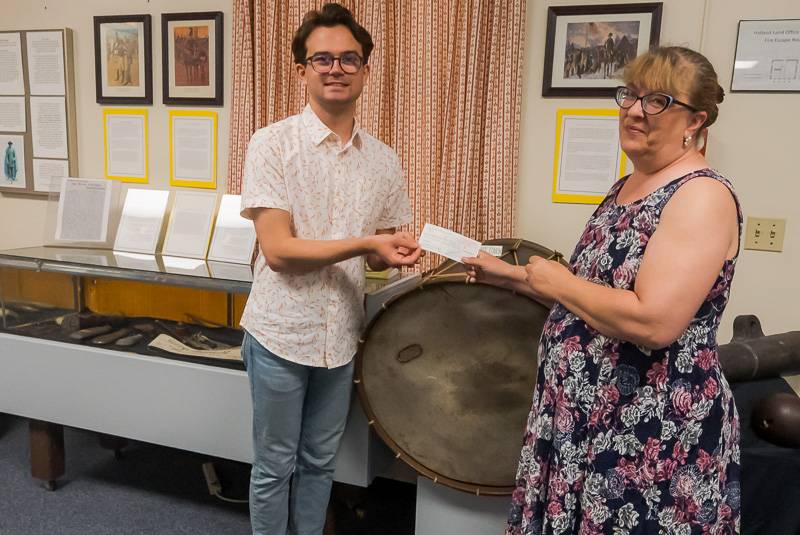
Photo by Howard Owens.
The men from Genesee County who fought in the War of 1812, the Civil War, and the wars of the 20th Century are well represented in the Holland Land Office Museum.
The men who served the cause of freedom starting in 1776 are less well represented, and the HLOM, with the help of the Anna Ingalsbe Lovell Chapter of the Daughters of the American Revolution, hopes to provide visitors to the museum information on those men who fight for liberty and then helped settle Western New York.
On Saturday, DAR members presented Tyler Angora, HLOM curator, with a check for $700 -- a $500 grant from DAR and $200 from the local chapter -- to create a display honoring the patriots who settled present-day Genesee County and immediately contiguous towns.
"There are a lot of people buried here but why did they come here? What did they do to help found our county?" said DAR member Robin Ettinger. "This is what our project is about."
In the past, DAR members identified all the patriots who purchased property from the land office and those names are already listed in a book in the research room. There are also men who acquired land in the county before the Holland Land Office started selling plots.
Western New York was not part of the colonies at the start of the Revolution.
The Senecas did not cede control of Western New York until the Treaty of the Big Tree in 1797. In the treaty, the Senecas agreed to establish residences on reservations in the territory and receive $100,000 (about $1.8 million today) for 3.75 million acres of land.
The Holland Land Company participated in the negotiations after acquiring rights a portion of the territory from Robert Morris in 1792.
Joseph Ellicott started surveying the land in 1798. Two years after Ellicott completed the survey, new settlers were able to buy plots of land in Genesee County (then, all of Western New York).
The project involved creating a slideshow of names and background information on the patriots to display on a flat-screen TV in the War Room.
"Right now, the only Revolutionary War piece that we have is the drum (acquired by a prior, now defunct DAR chapter)," Angora said. "We do talk about it on tours and stuff, but people don't actually get to see the men; they don't get to see their history. Ryan (Duffy, HLOM director) and I don't personally have the time to do that (put the display together). We're running the entire museum. We've wanted to expand this because the rest of the War Room has all the veterans listed except this part."
He said the TV will show a slide show of the men sharing their stories and showing their connections to this county and how they built this county, Angora said.
"We've researched them and we found a lot of men who purchased large plots, multiple plots in certain sections," Angora said. "Once the land office was here, they started flooding into this area to start farming because it was wilderness and it was a good opportunity for those patriots to come and build their lives here."
DAR members concentrate a lot on history and geology because in order to become a member, you must document that you have an ancestor who was either a patriot or supported a patriot at home.
Most of the patriots were farmers, but they were also mill owners, tavern owners, and shopkeepers.
"There's a lot of farmers and they just came out this way and had to have that tenacity to -- especially the women -- to say let's go out there and build log cabin. So the whole focus is what these guys did, who they were in the war, and they came out here and settled our area."
